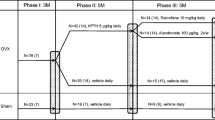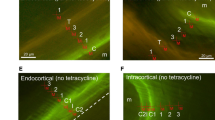Abstract
Summary
Improvements in total content of enzymatic cross-linking, the ratio of hydroxylysine-derived enzymatic cross-links, and non-enzymatic advanced glycation end product cross-link formation from once-weekly administration of hPTH(1–34) for 18 months in OVX cynomolgus monkeys contributed to the improvement of bone strength.
Introduction
Parathyroid hormone (PTH) is used for the treatment of osteoporosis. To elucidate the contribution of material properties to bone strength after once-weekly treatment with hPTH(1–34) in an ovariectomized (OVX) primate model, the content of collagen and enzymatic immature, mature, and non-enzymatic cross-links, collagen maturity, trabecular architecture, and mineralization in vertebrae were simultaneously estimated.
Methods
Adult female cynomolgus monkeys were divided into four groups (n = 18–20 each) as follows: SHAM group, OVX group, and OVX monkeys given once-weekly subcutaneous injections of hPTH(1–34) either at 1.2 or 6.0 μg/kg (low- or high-PTH groups) for 18 months. The content of collagen, enzymatic and non-enzymatic cross-linking pentosidine, collagen maturity, trabecular architecture, mineralization, and cancellous bone strength of vertebrae were analyzed.
Results
Low-PTH and high-hPTH treatments increased the content of enzymatic immature and mature cross-links, bone volume (BV/TV), and trabecular thickness, and decreased pentosidine, compared with the OVX group. Stepwise logistic regression analysis revealed that BV/TV, the content of total enzymatic cross-links, and calcium content independently affected ultimate load (model R 2 = 0.748, p < 0.001) and breaking energy (model R 2 = 0.702, p < 0.001). BV/TV was the most powerful and enzymatic cross-link content was the second powerful determinant of both ultimate load and breaking energy. The most powerful determinant of stiffness was the enzymatic cross-link content (model R 2 = 0.270, p < 0.001).
Conclusion
Once-weekly preventive administration of hPTH(1–34) increased the total contents of immature and mature enzymatic cross-links, which contributed significantly to vertebral cancellous bone strength.



Similar content being viewed by others
References
Lindsay R, Nieves J, Formica C et al (1997) Randomised controlled study of effect of parathyroid hormone on vertebral-bone mass and fracture incidence among postmenopausal women on oestrogen with osteoporosis. Lancet 350:550–555
Compston JE (2007) Skeletal actions of intermittent parathyroid hormone: effects on bone remodelling and structure. Bone 40:1447–1452
Neer RM, Arnaud CD, Zanchetta JR et al (2001) Effect of parathyroid hormone (1–34) on fractures and bone mineral density in postmenopausal women with osteoporosis. N Engl J Med 344:1434–1441
Fujita T, Inoue T, Morii H et al (1999) Effect of an intermittent weekly dose of human parathyroid hormone (1–34) on osteoporosis: a randomized double-masked prospective study using three dose levels. Osteoporos Int 9:296–306
Seeman E, Delmas PD (2006) Bone quality—the material and structural basis of bone strength and fragility. N Engl J Med 354:2250–2261
Knott L, Bailey AJ (1998) Collagen cross-links in mineralizing tissues: a review of their chemistry, function, and clinical relevance. Bone 22:181–187
Saito M, Marumo K (2010) Collagen cross-links as a determinant of bone quality: a possible explanation for bone fragility in aging, osteoporosis, and diabetes mellitus. Osteoporos Int 21:195–214
Viguet-Carrin S, Garnero P, Delmas PD (2006) The role of collagen in bone strength. Osteoporos Int 17:319–336
Banse X, Sims TJ, Bailey AJ (2002) Mechanical properties of adult vertebral cancellous bone: correlation with collagen intermolecular cross-links. J Bone Miner Res 17:1621–1628
Saito M, Fujii K, Soshi S et al (2006) Reductions in degree of mineralization and enzymatic collagen cross-links and increases in glycation-induced pentosidine in the femoral neck cortex in cases of femoral neck fracture. Osteoporos Int 17:986–995
Saito M, Soshi S, Fujii K (2003) Effect of hyper- and microgravity on collagen post-translational controls of MC3T3-E1 osteoblasts. J Bone Miner Res 18:1695–1705
Uzawa K, Grzesik WJ, Nishiura T et al (1999) Differential expression of human lysyl hydroxylase genes, lysine hydroxylation, and cross-linking of type I collagen during osteoblastic differentiation in vitro. J Bone Miner Res 14:1272–1280
Paschalis EP, Glass EV, Donley DW et al (2005) Bone mineral and collagen quality in iliac crest biopsies of patients given teriparatide: new results from the fracture prevention trial. J Clin Endocrinol Metab 90:4644–4649
Paschalis EP, Burr DB, Mendelsohn R et al (2003) Bone mineral and collagen quality in humeri of ovariectomized cynomolgus monkeys given rhPTH(1–34) for 18 months. J Bone Miner Res 18:769–775
Wang X, Shen X, Li X et al (2002) Age-related changes in the collagen network and toughness of bone. Bone 31:1–7
Saito M, Fujii K, Mori Y et al (2006) Role of collagen enzymatic and glycation induced cross-links as a determinant of bone quality in spontaneously diabetic WBN/Kob rats. Osteoporos Int 17:1514–1523
Oxlund H, Mosekilde L, Ortoft G (1996) Reduced concentration of collagen reducible cross links in human trabecular bone with respect to age and osteoporosis. Bone 19:479–484
Vashishth D (2007) The role of the collagen matrix in skeletal fragility. Curr Osteoporos Rep 5:62–66
Garnero P, Borel O, Gineyts E et al (2006) Extracellular post-translational modifications of collagen are major determinants of biomechanical properties of fetal bovine cortical bone. Bone 38:300–309
Saito M, Marumo K, Soshi S et al (2010) Raloxifene ameliorates detrimental enzymatic and nonenzymatic collagen cross-links and bone strength in rabbits with hyperhomocysteinemia. Osteoporos Int 21:655–666
Saito M, Mori S, Mashiba T et al (2008) Collagen maturity, glycation induced-pentosidine, and mineralization are increased following 3-year treatment with incadronate in dogs. Osteoporos Int 19:1343–1354
Tang SY, Vashishth D (2010) Non-enzymatic glycation alters microdamage formation in human cancellous bone. Bone 46:148–154
Saito M, Fujii K, Marumo K (2006) Degree of mineralization-related collagen crosslinking in the femoral neck cancellous bone in cases of hip fracture and controls. Calcif Tissue Int 79:160–168
Saito M, Marumo K, Fujii K et al (1997) Single-column high-performance liquid chromatographic-fluorescence detection of immature, mature, and senescent cross-links of collagen. Anal Biochem 253:26–32
Jerome CP, Burr DB, Van Bibber T et al (2001) Treatment with human parathyroid hormone (1–34) for 18 months increases cancellous bone volume and improves trabecular architecture in ovariectomized cynomolgus monkeys (Macaca fascicularis). Bone 28:150–159
Sato M, Westmore M, Ma YL et al (2004) Teriparatide [PTH(1–34)] strengthens the proximal femur of ovariectomized nonhuman primates despite increasing porosity. J Bone Miner Res 19:623–629
Hahn M, Vogel M, Pompesius-Kempa M, Delling G (1992) Trabecular bone pattern factor—a new parameter for simple quantification of bone microarchitecture. Bone 13:327–330
Laib A, Kumer JL, Majumdar S et al (2001) The temporal changes of trabecular architecture in ovariectomized rats assessed by MicroCT. Osteoporos Int 12:936–941
Hogan HA, Ruhmann SP, Sampson HW (2000) The mechanical properties of cancellous bone in the proximal tibia of ovariectomized rats. J Bone Miner Res 15:284–292
Leung KS, Siu WS, Cheung NM et al (2001) Goats as an osteopenic animal model. J Bone Miner Res 16:2348–2355
Saito M, Soshi S, Tanaka T et al (2004) Intensity-related differences in collagen post-translational modification in MC3T3-E1 osteoblasts after exposure to low- and high-intensity pulsed ultrasound. Bone 35:644–655
Easley SK, Jekir MG, Burghardt AJ et al (2010) Contribution of the intra-specimen variations in tissue mineralization to PTH- and raloxifene-induced changes in stiffness of rat vertebrae. Bone 46:1162–1169
Saito M, Shiraishi A, Ito M et al (2010) Comparison of effects of alfacalcidol and alendronate on mechanical properties and bone collagen cross-links of callus in the fracture repair rat model. Bone 46:1170–1179
Garnero P, Bauer DC, Mareau E et al (2008) Effects of PTH and alendronate on type I collagen isomerization in postmenopausal women with osteoporosis: the PaTH study. J Bone Miner Res 23:1442–1448
Khastgir G, Studd J, Holland N et al (2001) Anabolic effect of long-term estrogen replacement on bone collagen in elderly postmenopausal women with osteoporosis. Osteoporos Int 12:465–470
Robins SP (2007) Biochemistry and functional significance of collagen cross-linking. Biochem Soc Trans 35:849–852
Wu Y, Kumar R (2000) Parathyroid hormone regulates transforming growth factor beta1 and beta2 synthesis in osteoblasts via divergent signaling pathways. J Bone Miner Res 15:879–884
McCarthy TL, Centrella M, Canalis E (1989) Parathyroid hormone enhances the transcript and polypeptide levels of insulin-like growth factor I in osteoblast-enriched cultures from fetal rat bone. Endocrinology 124:1247–1253
Sowa H, Kaji H, Iu MF et al (2003) Parathyroid hormone–Smad3 axis exerts anti-apoptotic action and augments anabolic action of transforming growth factor beta in osteoblasts. J Biol Chem 278:52240–52252
Feres-Filho EJ, Choi YJ, Han X et al (1995) Pre- and post-translational regulation of lysyl oxidase by transforming growth factor-beta 1 in osteoblastic MC3T3-E1 cells. J Biol Chem 270:30797–30803
Reiser K, Summers P, Medrano JF et al (1996) Effects of elevated circulating IGF-1 on the extracellular matrix in “high-growth” C57BL/6J mice. Am J Physiol 271:R696–R703
Seitzer U, Batge B, Acil Y et al (1995) Transforming growth factor beta 1 influences lysyl hydroxylation of collagen I and reduces steady-state levels of lysyl hydroxylase mRNA in human osteoblast-like cells. Eur J Clin Invest 25:959–966
Jenniskens YM, Koevoet W, de Bart AC et al (2006) Biochemical and functional modulation of the cartilage collagen network by IGF1, TGFbeta2 and FGF2. Osteoarthritis Cartilage 14:1136–1146
Lowry MB, Lotinun S, Leontovich AA et al (2008) Osteitis fibrosa is mediated by platelet-derived growth factor-A via a phosphoinositide 3-kinase-dependent signaling pathway in a rat model for chronic hyperparathyroidism. Endocrinology 149:5735–5746
Chen P, Jerome CP, Burr DB et al (2007) Interrelationships between bone microarchitecture and strength in ovariectomized monkeys treated with teriparatide. J Bone Miner Res 22:841–848
Bailey AJ, Sims TJ, Ebbesen EN (1999) Age-related changes in the biochemical properties of human cancellous bone collagen: relationship to bone strength. Calcif Tissue Int 65:203–210
Knott L, Whitehead CC, Fleming RH et al (1995) Biochemical changes in the collagenous matrix of osteoporotic avian bone. Biochem J 310:1045–1051
Sell DR, Biemel KM, Reihl O et al (2005) Glucosepane is a major protein cross-link of the senescent human extracellular matrix. Relationship with diabetes. J Biol Chem 280:12310–12315
Biemel KM, Reihl O, Conrad J et al (2001) Formation pathways for lysine–arginine cross-links derived from hexoses and pentoses by Maillard processes: unraveling the structure of a pentosidine precursor. J Biol Chem 276:23405–23412
Acknowledgments
The authors are grateful to Ms. Mika Imamura and Ms. Kazumi Hirakawa (research assistants, Jikei University School of Medicine, Japan) for aiding specimen preparation and testing.
Conflicts of interest
None.
Author information
Authors and Affiliations
Corresponding author
Rights and permissions
About this article
Cite this article
Saito, M., Marumo, K., Kida, Y. et al. Changes in the contents of enzymatic immature, mature, and non-enzymatic senescent cross-links of collagen after once-weekly treatment with human parathyroid hormone (1–34) for 18 months contribute to improvement of bone strength in ovariectomized monkeys. Osteoporos Int 22, 2373–2383 (2011). https://doi.org/10.1007/s00198-010-1454-4
Received:
Accepted:
Published:
Issue Date:
DOI: https://doi.org/10.1007/s00198-010-1454-4




